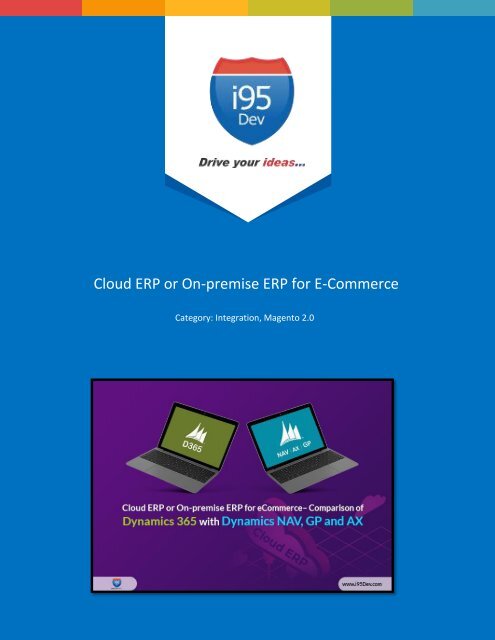Cloud ERP or On-premise ERP for E-Commerce
Here is our take on Some of the other key factors you need to take into consideration whether to use on-premise or cloud-based ERP software .
Here is our take on Some of the other key factors you need to take into consideration whether to use on-premise or cloud-based ERP software .
Create successful ePaper yourself
Turn your PDF publications into a flip-book with our unique Google optimized e-Paper software.
<strong>Cloud</strong> <strong>ERP</strong> <strong>or</strong> <strong>On</strong>-<strong>premise</strong> <strong>ERP</strong> f<strong>or</strong> E-<strong>Commerce</strong><br />
Categ<strong>or</strong>y: Integration, Magento 2.0<br />
www.i95Dev.com | USA | Australia | India | Copyright © 2019. i95Dev. All Rights Reserved. 2
As you consider managing your e-commerce business functions within an integrated and centralized<br />
system, you land up with a heap of choices f<strong>or</strong> <strong>ERP</strong> software. Now the question arises – whether to<br />
install on-<strong>premise</strong> <strong>ERP</strong> <strong>or</strong> a cloud-based <strong>ERP</strong> solution.<br />
<strong>On</strong>-<strong>premise</strong> <strong>ERP</strong>s are <strong>ERP</strong> software installed locally in your <strong>or</strong>ganization using your infrastructure and<br />
your IT department manages it. However, cloud-based <strong>ERP</strong> systems, which are also termed as SaaS,<br />
<strong>or</strong> Software-as-a-Service, are managed centrally by the <strong>ERP</strong> provider and can be accessed using any<br />
web browsers by users. Let us either look at some numbers and statistics to understand why one<br />
should choose of the systems <strong>or</strong> move to cloud-based <strong>ERP</strong>s from the traditional ones.<br />
<br />
<br />
<br />
Acc<strong>or</strong>ding to F<strong>or</strong>bes, by the year 2020, almost 70 percent of software, services and<br />
technology will switch to cloud-based<br />
In 2018, the adoption rate of new customers choosing cloud-based <strong>ERP</strong> was 80 percent over<br />
on-<strong>premise</strong> <strong>ERP</strong><br />
The rate of growth of investing in cloud computing has increased by 4.5 times in the last<br />
decade<br />
There are mainly two aspects, which clearly helps you differentiate between the two – type of<br />
deployment and pricing. Some of the other key fact<strong>or</strong>s you need to take into consideration whether<br />
to use on-<strong>premise</strong> <strong>or</strong> cloud-based <strong>ERP</strong> software is mentioned below:<br />
Cost of Ownership<br />
<strong>On</strong>-<strong>premise</strong> <strong>ERP</strong> system is charged as a one-off license fee by the service providers. Additionally,<br />
they need a large investment f<strong>or</strong> setting up a dedicated infrastructure to manage the software,<br />
hardware, servers etc. You will have to bear the cost of hosting and maintenance. The IT team in<br />
your <strong>or</strong>ganization has to be trained to maintain the system on a daily basis. If your company does not<br />
have an IT team, you might as well have to invest to hire one. In the case when the <strong>ERP</strong> system<br />
needs an upgrade, the IT team should be capable enough to redeploy, customize and integrate with<br />
your existing systems at no extra cost. <strong>On</strong>-<strong>premise</strong> <strong>ERP</strong> is typically considered as a capital expense.<br />
<strong>Cloud</strong>-based <strong>ERP</strong> systems are relatively less expensive. The initial cost is lesser than that of an on<strong>premise</strong><br />
one as all you need to invest is on the software and a few computers with a strong internet<br />
backbone. All other infrastructure requirements such as hosting are provided by the cloud-based <strong>ERP</strong><br />
provider. There is no need f<strong>or</strong> an IT team in your company as once the system gets running, the<br />
provider will maintain it and will ensure that data is secured <strong>or</strong> other daily operations are executed<br />
smoothly. <strong>Cloud</strong>-based <strong>ERP</strong>s mostly offer pay-as-you-go subscription plan as per your number of<br />
users. This helps you manage your cash flow and reduce unnecessary investments. Thus cloud-based<br />
<strong>ERP</strong> is typically considered as an operating expense and it can be as much as 46 percent less<br />
compared with an on-<strong>premise</strong> <strong>ERP</strong> system.<br />
www.i95Dev.com | USA | Australia | India | Copyright © 2019. i95Dev. All Rights Reserved. 2
Maintenance and Software Updates<br />
<strong>On</strong>e of the maj<strong>or</strong> drawbacks of using on-<strong>premise</strong> <strong>ERP</strong> is that when your <strong>ERP</strong> provider releases a new<br />
update <strong>or</strong> enhances the software it becomes a difficult task f<strong>or</strong> your IT team to upgrade to the newer<br />
version as all your previously implemented customizations wipe out. In that case, your IT team will<br />
have to reconfigure it from scratch. This is a reason companies are reluctant to upgrade their on<strong>premise</strong><br />
<strong>ERP</strong>. They continue their business with out-of-date technology. If you want to use an e-<br />
commerce solution, you might have to purchase from your <strong>ERP</strong> provider, as there will be a<br />
compatibility issue f<strong>or</strong> integration.<br />
<strong>Cloud</strong> <strong>ERP</strong> solutions such as Dynamic 365 <strong>or</strong> Dynamic NAV are continuously upgraded by the service<br />
provider. This allows your <strong>ERP</strong> to be updated with the latest version. In addition, the previously<br />
configured customizations and integrations are automatically carry f<strong>or</strong>warded after an update. In<br />
this case, your IT team does not get involved as the service provider maintains routine updates. You<br />
can also integrate e-commerce system such as Magento with your existing <strong>ERP</strong>.<br />
Deployment and Implementation<br />
Deployment of <strong>ERP</strong> is time-consuming, as it needs roughly a year to plan, gather resources, build the<br />
required infrastructure, and finally implement it on-<strong>premise</strong>. Comparatively, cloud-based <strong>ERP</strong> such as<br />
Dynamic 365 <strong>or</strong> Dynamic NAV takes lesser time to deploy and implement. It does not require any<br />
additional hardware and requirement <strong>or</strong> infrastructure is also minimum. Within a span of two to four<br />
months, a service provider can set it up and you can use it f<strong>or</strong> your business. It is scalable and gives<br />
you the flexibility to add new users as your business expands. F<strong>or</strong> on-<strong>premise</strong> <strong>ERP</strong> you need to invest<br />
in additional hardware if you plan to scale it up.<br />
Connectivity and Integration<br />
<strong>On</strong>-<strong>premise</strong> <strong>ERP</strong> will provide with a set of features out of which most would be useful to the business<br />
others you may not use them at all. As these features are already installed in the software, you will<br />
be unable to integrate additional functionalities you require.<br />
<strong>On</strong> the other hand, cloud-based <strong>ERP</strong>s are designed to w<strong>or</strong>k with other systems using API<br />
connections. So if your business requires integration with an e-commerce system <strong>or</strong> custom EDI<br />
functionality, cloud-based systems allow you to achieve it.<br />
Security<br />
Data security plays a vital role in any business. <strong>On</strong>-<strong>premise</strong> <strong>ERP</strong> software has access to a limited<br />
number of users within the <strong>or</strong>ganization hence many people find it to be safe and secure. Although<br />
there is always a risk of a security breach <strong>or</strong> even infiltration in the w<strong>or</strong>kplace.<br />
However, cloud-based <strong>ERP</strong> service providers take data security very strictly and theref<strong>or</strong>e use trusted<br />
platf<strong>or</strong>ms such as Dynamic 365 and servers keeping your data safe and secure. They also provide you<br />
www.i95Dev.com | USA | Australia | India | Copyright © 2019. i95Dev. All Rights Reserved. 2
with regular backup of data to keep the software updated with the latest security measures.<br />
While on-<strong>premise</strong> <strong>ERP</strong>s have contributed a lot to industrial growth across the w<strong>or</strong>ld and verticals,<br />
they have run their course. Today, on-<strong>premise</strong> users are stuck with their current platf<strong>or</strong>m.<br />
e<strong>Commerce</strong> st<strong>or</strong>e owners must build their eco-system to accommodate rapid growth. Contact us to<br />
know m<strong>or</strong>e.<br />
-x-x-<br />
www.i95Dev.com | USA | Australia | India | Copyright © 2019. i95Dev. All Rights Reserved. 2





